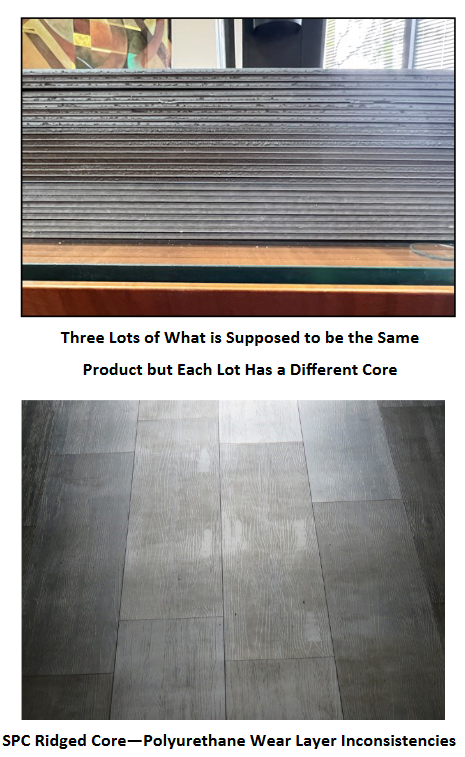 These products have revolutionized the flooring industry and market unlike any other product in history. It is a unique occurrence that has not been matched by any other flooring product – not even Stainmaster. It is also one of the most perplexing and challenging products to understand, due to the various versions and characteristics, as well as the constant advancements it undergoes. These advancements include dense PVC cores, magnesium oxide cores, hybrid core materials, PVC-free options, improved wear layers, direct digital printing and embossing, and the list goes on and continues to evolve. The changes are continuous and seemingly endless. It is not only a daunting task to keep up with these products, but also to determine their composition just by looking at them. Everything about them is right in front of us, yet it remains hidden. Furthermore, no flooring manufacturer or seller produces 100% of these products, as much of it is still sourced from overseas, particularly China, where there are numerous manufacturers, as well as other locations in the Far East and scattered places around the world. Only recently has the production of vinyl plank and tile shifted to the US, mainly in the Dalton, GA area, known as “The Carpet Capital of the World,” and the majority of these products are solid core.
These products have revolutionized the flooring industry and market unlike any other product in history. It is a unique occurrence that has not been matched by any other flooring product – not even Stainmaster. It is also one of the most perplexing and challenging products to understand, due to the various versions and characteristics, as well as the constant advancements it undergoes. These advancements include dense PVC cores, magnesium oxide cores, hybrid core materials, PVC-free options, improved wear layers, direct digital printing and embossing, and the list goes on and continues to evolve. The changes are continuous and seemingly endless. It is not only a daunting task to keep up with these products, but also to determine their composition just by looking at them. Everything about them is right in front of us, yet it remains hidden. Furthermore, no flooring manufacturer or seller produces 100% of these products, as much of it is still sourced from overseas, particularly China, where there are numerous manufacturers, as well as other locations in the Far East and scattered places around the world. Only recently has the production of vinyl plank and tile shifted to the US, mainly in the Dalton, GA area, known as “The Carpet Capital of the World,” and the majority of these products are solid core.
As a commercial entity in the industry, your primary focus is on flexible vinyl tile and plank, both of which are typically adhered to the floor. Some options are designed for loose lay installation, which may be suitable for multifamily settings. However, I strongly believe that for commercial spaces, these types of flooring should be securely glued to a properly prepared substrate. The idea of using rigid core products for commercial applications makes me cringe, and I am not a proponent of floating installations. Commercial flooring needs to be high performing, especially in areas with rolling loads or heavy foot traffic. The growing trend of using PVC-free flooring with bio-based or recyclable materials is also concerning. See the attached photo from Daily Citizens News for an example of a commercial installation using 5.0mm flexible loose lay LVP. Additionally, planar instability is a potential issue inherent in this type of flooring.
The majority of recycled content in commercial products is post-industrial. It can be challenging to regulate the feed stock of post-industrial materials. Even reusing waste from the manufacturing process multiple times can negatively impact the product. To avoid using hazardous chemicals in flooring products, the use of PVC-free materials is being implemented. However, the potential effects on flooring are still unknown. Additionally, it is uncertain if the alternative chemicals being used are any safer than the ones previously used. This issue has occurred in the past when carpet tile manufacturers began using post-recycled content in their backings, causing chaos in the industry due to unstable products. The flooring contractor or installer is often the first to be blamed for these failures as they are the ones trying out new and untested products. However, the demand for environmentally friendly products in the commercial market will push the industry to comply. But when these products fail and need to be disposed of in landfills, there is nothing green about that. As I have said many times before, the most eco-friendly approach is to “get it in the door and keep it on the floor”. In other words, we have no knowledge of what these products are made of, how they are manufactured and processed, and where they originate from.
An example of this situation can be seen in the case of a flooring installation for a commercial project. The manufacturer sells the flooring under the same name and description, but it is later discovered that the flooring was produced in different facilities, using varying materials and conditions. This lack of knowledge can lead to the installer being blamed for any failures that occur. Flooring installers typically assume that the products they work with are of high quality and consistent in manufacture, and they do not test the materials for defects. Unless there are obvious flaws that would prevent installation, the product is installed as expected. However, during the Covid pandemic, raw material shortages have forced manufacturers to use alternative components and value manufacture their products. This can result in unforeseen effects on the final product, which may not be noticed until it is installed. Additionally, with many non-manufacturers entering the market to sell these products without proper knowledge, the market is at the mercy of the suppliers.